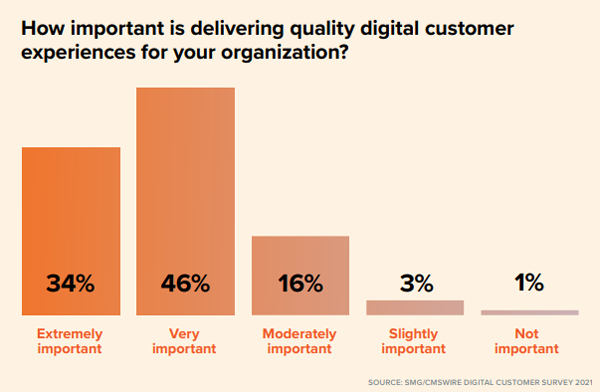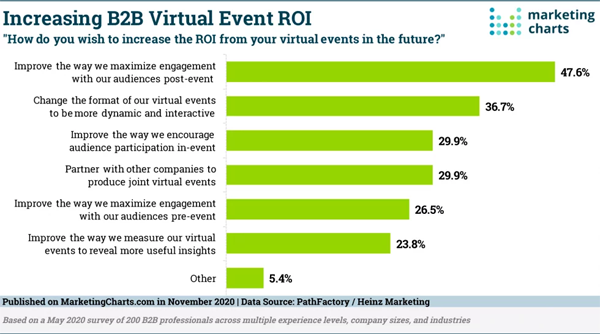
Catching a movie in a packed theater. Crowding into a stadium with tens of thousands of fans for a sporting event or concert. Attending a bustling business expo in a convention center brimming with industry peers.
All of the above are previous mainstays that went noticeably amiss this year, lost to the ruthlessness of 2020 along with so many other in-person experiences. And while such large-scale gatherings will surely return to our lives at some point, the undeniable reality is that we don’t know when. We do know it won’t magically happen once the calendar flips forward. Analysts believe physical events may not return until 2022.
Because of this, and larger trends that supersede COVID-19’s impact, entities like the movie industry and sports leagues are strategizing for 2021 — and beyond — around digital-first models, designed to maximize the quality of user experiences while optimizing for distribution and monetization.
Businesses should be intent upon doing the same. And according to CMSWire’s 2021 State of the Digital Customer Experience report, a vast majority of them are:

Digital Customer Experience Is a Decisive Differentiator
Historically, department stores have placed a substantial emphasis on the in-store experience. Everything from lighting to layout to customer service is scrutinized to the extreme. Delighting shoppers at every turn means they are less likely to take their business elsewhere. It might even mean they’re willing to pay a premium for your goods.
Similar dynamics are in play for the rapidly accelerating digital business landscape. Except if you run a department store’s online presence, you’re no longer benchmarking yourself strictly against fellow retailers in the same space.
“Customers don’t compare you only to your direct competition anymore,” writes Shep Hyken in an article for Forbes on eradicating mediocrity. “Customers now compare you to the best service they have received from anyone, regardless of the type of business or industry.”
“Customers don’t compare you only to your direct competition anymore. Customers now compare you to the best service they have received from anyone, regardless of the type of business or industry.” — Shep Hyken @Hyken Click To Tweet
Indeed, customers’ digital expectations have risen in retail and elsewhere since the advent of COVID-19. B2B companies are generally a bit further along in their digital maturity, but 2021 is an opportunity to separate yourself from the pack. Invest in digital transformation where it counts: customer-facing touchpoints.
A study last year by Kony found that, of the trillions of dollars being invested in digital transformation, only 28% were focused on the customer experience, with a much larger portion centered on business processes.
Building digital infrastructure is important, no doubt, but back-end efficiency won’t win customers and generate buzz in the market. With an eye on creating a differentiated digital customer experience in 2021, let’s zero in on some areas worth exploring.
Key Focal Points for Digital Customer Experience in 2021
Here are four ways that today’s B2B organizations can improve the quality of engagements, strengthen trust, and develop a sustainable strategy for success in our permanently altered environment.
1 — Embrace Technology to Innovate Digital Engagement
A recent article in Harvard Business Review articulated the need for industrial firms to give their customers a digital experience. Here are a few sector-specific stats shared in the piece, via research by L.E.K.:
- Building and construction customers use digital channels 80-90% of the time to gather information, read reviews, compare prices, and check product quality/availability.
- Across all industries, upwards of 40% of planned purchases are now made on websites or mobile apps.
- 83% of the industrial firms that have been most successful at increasing revenue, market share or net promoter score (NPS), say they have made meaningful investments in digital customer engagement versus only 19% of less successful firms.
Industrial customers, like any customers, want a smooth and frictionless digital experience. They want information that is clear and easy to find. And they will respond to creativity and innovation.
HBR’s article mentions several noteworthy examples of industrial organizations going above and beyond to provide great digital experiences.
A global industrial gases and engineering solutions company called Linde uses augmented reality to project the image of their cryogenic freezer into a prospective customer’s factory setup. Similarly, building-products company Azek developed a 3D visualization tool that helps customers get an idea of what their products will look like upon completion (then leverages insight gained through the interactions). Global chemical distribution Brenntag partnered with DigiB to create a self-service portal for customers, using machine learning to tailor experiences and product recommendations.
How can you take advantage of emerging tools and technologies to stand out with your customers in the digital universe?
2— Aim for Omni-channel Presence and Consistency
Seamless consistency is the name of the game for digital customer experiences. Businesses should be easy to find and engage with across various channels and platforms. In laying out five key challenges to building a successful omni-channel customer experience strategy at CMSwire, Rich Hein points to these barriers:
- Overcoming data silos
- Unifying omnichannel data
- Personalizing across channels
- Creating a consistent experience
- Real time decisioning
It’s all about taking a holistic view of every customer touchpoint to ensure they are strategically connected. To see what this looks like in action, check out Clint Fontanella’s recent feature for HubSpot highlighting 15 examples of brilliant omni-channel brand experiences.
3— Build Trust through Customer Data
Customer data can be our greatest asset and our greatest obstacle. I’ve written before that marketers have an opportunity to turn the tides on mounting consumer distrust toward data practices in business. This opportunity is now riper than ever at a time where digital data is proliferating and trust hangs in the balance.
A key frontier for activating the power of customer insight lies in micro data, according to Billee Howard in a recent article for Forbes describing a CX-Centric Future Powered By Customer Advocacy, Micro Data + Emotion.
“In today’s world, brand loyalty is swiftly being reimagined via the ability to deliver a strategic marriage of brand utility and emotional acuity,” she writes. “This type of brand super power will be borne from an ability to discover ‘micro’ data that yields surgical customer understanding that can catalyze 1:1 commercial intimacy. To do this, brand leaders will need to continue to find new approaches to customer segmentation that unearth not only points of differentiation, but areas of commonality. In an ultimate scenario, these things will meld together to create the type of empathy delivery today’s customer not only expects, but demands.”
When done right, this one-to-one engagement can build strong trust and rapport. But brands must be cognizant of customer sensitivities around personal data. A recent report from professional services firm KPMG found that “U.S. consumers are becoming increasingly concerned with — and distrustful of — how companies use, manage, and protect their personal data.” In the survey, 97% of respondents said data privacy was important to them and 87% characterized it as a human right.
Delivering a great digital customer experience isn’t only about tapping into the potential offered by this new environment, but also removing inhibitions and reservations that rightfully come along with it.
4— Find Compelling Ways to Bring In-person Experiences Online
There’s no reason to view virtual events as a burden made necessary by the pandemic and social distancing. Yes, we all miss traveling and getting together with people, but digital gatherings can serve as a valuable replacement for now and a powerful complement once normalcy returns. There is all kind of upside in enhancing your capabilities on this front.
PathFactory and Heinz Marketing asked B2B marketers how they would like to increase ROI from virtual events in the future. The top answer, selected by nearly half of respondents, was improving the way they maximize engagement with audiences post-event. The second-most popular response was changing the format of virtual events to become more dynamic and interactive.

The biggest mistake we can make is trying to pigeonhole a live event into a virtual format. They just aren’t the same. Moz CMO Christina Mautz recently shared learnings from taking MozCon completely virtual for the first time, and talked about the need to fundamentally rethink how we approach online experiences. Elsewhere, Oracle’s Larry Ellison and Rob Tarkoff chatted during their company’s own virtual summit about the future of CX.
Plan Now, Profit Later
Leagues like Major League Baseball and the National Basketball Association incorporated all kinds of new bells and whistles in their broadcasts this season, from in-game interviews to interactive features to increased streaming accessibility. And this was implemented on a tight timeline in reaction to unexpected circumstances. Imagine what these entertainment powerhouses might come up with for 2021, with full offseasons to devise plans and research evolving customer preferences for digital engagement.
The business world is in a similar position. We’ve all been adapting on the fly to this year’s events, but as we look ahead to 2021 we can begin to frame our strategic planning around the “new normal.”
That means making digital customer experiences an utmost priority.
Want to learn more about taking customer experiences to the next level? Read our post on how influence and SEO can join forces to drive CX forward

Comments are Closed